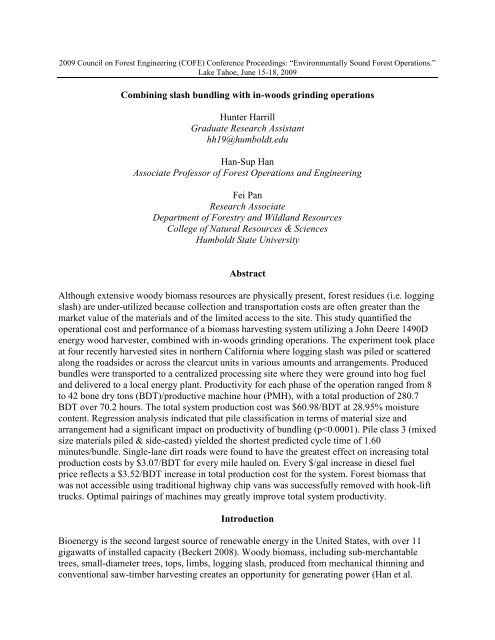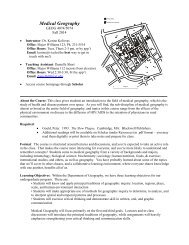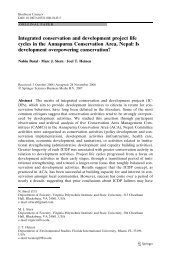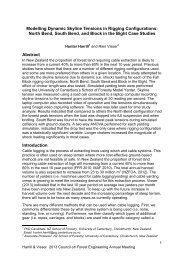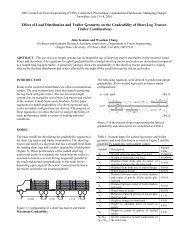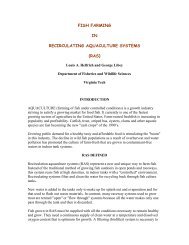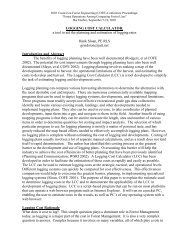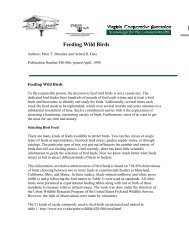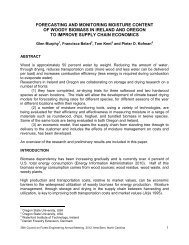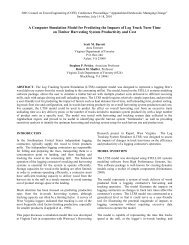Combining slash bundling with in-woods grinding operations
Combining slash bundling with in-woods grinding operations
Combining slash bundling with in-woods grinding operations
You also want an ePaper? Increase the reach of your titles
YUMPU automatically turns print PDFs into web optimized ePapers that Google loves.
2009 Council on Forest Eng<strong>in</strong>eer<strong>in</strong>g (COFE) Conference Proceed<strong>in</strong>gs: “Environmentally Sound Forest Operations.”<br />
Lake Tahoe, June 15-18, 2009<br />
<strong>Comb<strong>in</strong><strong>in</strong>g</strong> <strong>slash</strong> <strong>bundl<strong>in</strong>g</strong> <strong>with</strong> <strong>in</strong>-<strong>woods</strong> gr<strong>in</strong>d<strong>in</strong>g <strong>operations</strong><br />
Hunter Harrill<br />
Graduate Research Assistant<br />
hh19@humboldt.edu<br />
Han-Sup Han<br />
Associate Professor of Forest Operations and Eng<strong>in</strong>eer<strong>in</strong>g<br />
Fei Pan<br />
Research Associate<br />
Department of Forestry and Wildland Resources<br />
College of Natural Resources & Sciences<br />
Humboldt State University<br />
Abstract<br />
Although extensive woody biomass resources are physically present, forest residues (i.e. logg<strong>in</strong>g<br />
<strong>slash</strong>) are under-utilized because collection and transportation costs are often greater than the<br />
market value of the materials and of the limited access to the site. This study quantified the<br />
operational cost and performance of a biomass harvest<strong>in</strong>g system utiliz<strong>in</strong>g a John Deere 1490D<br />
energy wood harvester, comb<strong>in</strong>ed <strong>with</strong> <strong>in</strong>-<strong>woods</strong> gr<strong>in</strong>d<strong>in</strong>g <strong>operations</strong>. The experiment took place<br />
at four recently harvested sites <strong>in</strong> northern California where logg<strong>in</strong>g <strong>slash</strong> was piled or scattered<br />
along the roadsides or across the clearcut units <strong>in</strong> various amounts and arrangements. Produced<br />
bundles were transported to a centralized process<strong>in</strong>g site where they were ground <strong>in</strong>to hog fuel<br />
and delivered to a local energy plant. Productivity for each phase of the operation ranged from 8<br />
to 42 bone dry tons (BDT)/productive mach<strong>in</strong>e hour (PMH), <strong>with</strong> a total production of 280.7<br />
BDT over 70.2 hours. The total system production cost was $60.98/BDT at 28.95% moisture<br />
content. Regression analysis <strong>in</strong>dicated that pile classification <strong>in</strong> terms of material size and<br />
arrangement had a significant impact on productivity of <strong>bundl<strong>in</strong>g</strong> (p
2004). Forest <strong>operations</strong> have the potential to supply 368 million dry tons of woody biomass<br />
annually (Perlack et al. 2005). The annual available biomass <strong>in</strong> California was estimated at 26.8<br />
million dry tons (Tiangco et al. 2005). Prescribed burn<strong>in</strong>g has long been the preferred method of<br />
dispos<strong>in</strong>g of forest biomass, but mechanical removal of biomass is becom<strong>in</strong>g more popular due<br />
to <strong>in</strong>creased restrictions on open field burn<strong>in</strong>g, or <strong>in</strong> areas like the wildland urban <strong>in</strong>terface<br />
(WUI) where burn<strong>in</strong>g is not an option.<br />
Forest residues are often not utilized because collection and transportation costs are greater than<br />
the market value of the materials (Withycombe 1982). Lack of research <strong>in</strong> this field has made<br />
harvest<strong>in</strong>g and transportation costs are notoriously difficult to estimate because there are critical<br />
gaps <strong>in</strong> the data and methods for predict<strong>in</strong>g costs (Rummer et al. 2008).<br />
New, more efficient harvest<strong>in</strong>g equipment like energy wood harvesters could reduce the<br />
associated process<strong>in</strong>g costs <strong>with</strong> their <strong>in</strong>creased productivity. These mach<strong>in</strong>es compact and<br />
bundle woody biomass <strong>in</strong>to log-shaped bundles, and could produce up to 40 half-ton bundles per<br />
hour <strong>with</strong> a production cost of $16 per dry ton (Rummer et al. 2004). Quantify<strong>in</strong>g costs and<br />
productivities of these new systems for biomass recovery from northern California will aid land<br />
managers <strong>in</strong> the plann<strong>in</strong>g and execution of cost-effective biomass supply for energy.<br />
The overall objective of this project was to determ<strong>in</strong>e the operational cost and performance of a<br />
biomass collection and densification system, called <strong>slash</strong> bundler, <strong>in</strong> comb<strong>in</strong>ation <strong>with</strong> a<br />
centralized gr<strong>in</strong>d<strong>in</strong>g operation. Important variables, such as haul<strong>in</strong>g distance and moisture<br />
contents, were itemized to understand their effects on productivity of collection and<br />
transportation. In particular, <strong>slash</strong> piles were characterized to evaluate the effect of <strong>slash</strong> type on<br />
productivity, based on arrangement and size of <strong>slash</strong> materials.<br />
Methodology<br />
Study site and system description<br />
The study was conducted <strong>in</strong> three clearcut harvest<strong>in</strong>g sites <strong>in</strong> northern California, rang<strong>in</strong>g from<br />
17 to 32 acres. The vegetation at each site varied but was generally dom<strong>in</strong>ated by second growth<br />
redwood (Sequoia sempervirens) and Douglas-fir (Pseudotsuga menziesii) <strong>with</strong> an average tree<br />
age of 60 years. The three sites had an average tree diameter at breast height (DBH) rang<strong>in</strong>g<br />
from 20-22 <strong>in</strong>ches, and ground slopes ranged from 0 to 30 percent. The stands were harvested<br />
us<strong>in</strong>g a ground-based shovel logg<strong>in</strong>g system. There were many <strong>slash</strong> pile types <strong>in</strong> terms of size<br />
and arrangement present across these sites (Fig. 1). A forester work<strong>in</strong>g for the land owner<br />
suggested these sites were expected to yield anywhere from 50-75 tons/ac of <strong>slash</strong> from clearcut<br />
<strong>operations</strong> (Alcorn 2008).
Pile Class 1 = Mixed size material,<br />
loader piled<br />
Pile Class 2 = Large size material,<br />
processor piled<br />
Pile Class 3 = Mixed size material,<br />
side-cast piled<br />
Pile Class 4 = Mixed size material,<br />
processor piled<br />
Pile Class 5 = Small size material,<br />
loader piled<br />
Pile Class 6 = Mixed size material,<br />
side-cast<br />
Figure 1: Slash pile classification by arrangement and material size.<br />
A two week trial was conducted to collect and process woody residues after commercial timber<br />
harvest<strong>in</strong>g <strong>operations</strong>. The system collected material pre-piled at land<strong>in</strong>gs and along roadsides<br />
<strong>with</strong> a <strong>slash</strong> bundler (John Deere 1490D). The bundler compacted and wrapped <strong>slash</strong> <strong>in</strong>to 10ft<br />
long bundles <strong>with</strong> an average diameter of 27 <strong>in</strong>ches. Bundles were then loaded <strong>in</strong>to 40 cubic yard<br />
conta<strong>in</strong>ers along the roadside <strong>with</strong> a loader (Hitachi EX 200-3). The bundles were delivered to a<br />
nearby central gr<strong>in</strong>d<strong>in</strong>g location (< 3 miles; Fig. 3) by hook-lift trucks. A gr<strong>in</strong>der (Peterson<br />
Pacific 7400) was set up at the centralized gr<strong>in</strong>d<strong>in</strong>g site and ground all the bundles <strong>in</strong>to hog fuel.<br />
Hog fuel was then belt fed <strong>in</strong>to 120 cubic yard chip vans and transported to a local power plant.
Figure 2: John Deere 1490D energy wood harvester which produces the bundles, and hook-lift<br />
truck used to haul bundles.<br />
Dirt road<br />
0.92<br />
miles<br />
Unit A<br />
2⁰ Gravel road<br />
0.68<br />
miles<br />
Unit B<br />
1⁰ Gravel road<br />
1.64<br />
miles<br />
Unit C<br />
Centralized<br />
gr<strong>in</strong>d<strong>in</strong>g<br />
site<br />
Figure 3: Operation layout map <strong>with</strong> correspond<strong>in</strong>g road segments.<br />
Data collection and analysis<br />
Hourly mach<strong>in</strong>e costs (Table 2) measured <strong>in</strong> dollars per scheduled mach<strong>in</strong>e hour (SMH) were<br />
calculated us<strong>in</strong>g standard mach<strong>in</strong>e rate calculation method (Miyata 1980). For each mach<strong>in</strong>e <strong>in</strong><br />
the system purchase price, <strong>in</strong>surance and tax rates, repair costs, fuel consumption, and labor costs<br />
were obta<strong>in</strong>ed from the contractor, diesel fuel price receipts were averaged throughout length of<br />
the operation ($4.60/gal). All mach<strong>in</strong>ery were assumed to work 1800 SMH annually and have an<br />
economic life of ten years except for the gr<strong>in</strong>der which was 5 year economic life due to<br />
associated wear, and the bundler which was assumed to work 2100 SMH as suggested by John<br />
Deere Company.
Time study data was collected to calculate hourly production (bone dry ton (BDT)/productive<br />
mach<strong>in</strong>e hour (PMH)) us<strong>in</strong>g standard time study techniques for each element <strong>in</strong> a mach<strong>in</strong>es<br />
operation cycle by stop watch (Olsen et al. 1998). A <strong>bundl<strong>in</strong>g</strong> cycle <strong>in</strong>cludes travel<strong>in</strong>g to the<br />
<strong>slash</strong> pile, followed by multiple grapples and sw<strong>in</strong>gs of <strong>slash</strong> to the <strong>in</strong>-feed table, and ended<br />
when the bundle produced was cut free from the mach<strong>in</strong>e. A load<strong>in</strong>g cycle started from travel<strong>in</strong>g<br />
to a bundle, followed by sw<strong>in</strong>g<strong>in</strong>g empty to the bundle, grappl<strong>in</strong>g the bundle, sw<strong>in</strong>g<strong>in</strong>g loaded<br />
back to the conta<strong>in</strong>er, and ended by compact<strong>in</strong>g bundle <strong>in</strong>to the conta<strong>in</strong>er. A hook-lift truck<strong>in</strong>g<br />
cycle <strong>in</strong>cludes travel<strong>in</strong>g empty to the harvest unit, position<strong>in</strong>g the truck for load<strong>in</strong>g, load<strong>in</strong>g a<br />
conta<strong>in</strong>er filled <strong>with</strong> bundles, travel<strong>in</strong>g loaded to the centralized gr<strong>in</strong>d<strong>in</strong>g site, and<br />
unload<strong>in</strong>g/dump<strong>in</strong>g the bundles. Three types of delay time, <strong>in</strong>clud<strong>in</strong>g operational delays,<br />
mechanical delays and personal delays, were recorded.<br />
Regression models for delay-free cycle time were developed us<strong>in</strong>g the pre-identified <strong>in</strong>dependent<br />
variables associated <strong>with</strong> each cycle. The collected time study data were screened for normality<br />
and outliers us<strong>in</strong>g histograms and residual plots, and were used to develop predictive equations<br />
by runn<strong>in</strong>g multiple regressions us<strong>in</strong>g ord<strong>in</strong>ary least squares estimators, performed <strong>in</strong> R 2.4.1<br />
statistical software program (R 2006). The f<strong>in</strong>al predictive models only <strong>in</strong>clude variables that<br />
were statistically significant (p-value
undl<strong>in</strong>g, load<strong>in</strong>g and haul<strong>in</strong>g, and gr<strong>in</strong>d<strong>in</strong>g stages of operation respectively. Regional delivered<br />
hog fuel prices dur<strong>in</strong>g the time of study was surveyed at $50 a bone dry ton (BDT).<br />
Results & Discussion<br />
Cycle time regression equations<br />
Regression equations developed from the time study data <strong>with</strong> significant variables (p < 0.05, α<br />
= 0.05) were summarized <strong>in</strong> Table 3. Both models for the bundler and the hook-lift truck had<br />
high r-squared values, <strong>in</strong>dicat<strong>in</strong>g that they might be effective <strong>in</strong> estimat<strong>in</strong>g the productivity for<br />
load<strong>in</strong>g and haul<strong>in</strong>g.<br />
Bundl<strong>in</strong>g cycle time was affected ma<strong>in</strong>ly by different handl<strong>in</strong>g and arrang<strong>in</strong>g activities such as,<br />
the number of grapples to pick up <strong>slash</strong>, or the number of <strong>in</strong>-feeds to place the <strong>slash</strong> on the <strong>in</strong>feed<br />
table for <strong>bundl<strong>in</strong>g</strong>. The grappl<strong>in</strong>g element consumed the greatest amount of time dur<strong>in</strong>g an<br />
average <strong>bundl<strong>in</strong>g</strong> cycle (0.85 m<strong>in</strong>utes, 44.5%), while the travel<strong>in</strong>g element was responsible for<br />
the smallest portion of cycle time (0.09 m<strong>in</strong>utes, 4.8%; Figure 4). This was most likely due to the<br />
fact that the mach<strong>in</strong>e could rema<strong>in</strong> stationary because of the amount of <strong>slash</strong> available <strong>with</strong><strong>in</strong><br />
reach, and spent the greatest of time grappl<strong>in</strong>g <strong>in</strong> order to properly align <strong>slash</strong> for efficient <strong>in</strong>feed<strong>in</strong>g.<br />
The regression equation also <strong>in</strong>dicated that the number of sw<strong>in</strong>g cycles for which the<br />
bundler picks up <strong>slash</strong> and places it on the <strong>in</strong>-feed table had a significant effect on cycle time.<br />
When consider<strong>in</strong>g the effect of pile classification on estimated <strong>bundl<strong>in</strong>g</strong> cycle time, pile class 1,<br />
pile class 2, and pile class 6 were the only pile classes found to be statistically significant (pvalue<br />
Grappl<strong>in</strong>g the bundles and compact<strong>in</strong>g them <strong>in</strong>to the b<strong>in</strong> proves to significantly affect the load<strong>in</strong>g<br />
cycle time. Loaded sw<strong>in</strong>g degrees <strong>in</strong> which the mach<strong>in</strong>e had to rotate to place a bundle <strong>in</strong> the b<strong>in</strong><br />
was also found to be significant, along <strong>with</strong> the travel distance necessary to reach a bundle. The<br />
regression analysis suggests that decreas<strong>in</strong>g the travel distance and m<strong>in</strong>imiz<strong>in</strong>g sw<strong>in</strong>g degrees<br />
would greatly reduce the predicted cycle time.<br />
The transportation distance along various road types positively affected the haul<strong>in</strong>g cycle time.<br />
Only loaded haul<strong>in</strong>g distances were used to develop the truck<strong>in</strong>g regression equation because the<br />
same routes were used to and from harvest units. The position<strong>in</strong>g distance for a hook-lift truck to<br />
position himself to be loaded was also found to have a significant effect on cycle time because<br />
this was done while driv<strong>in</strong>g <strong>in</strong> reverse, and had to be done carefully to properly align himself for<br />
load<strong>in</strong>g by the Hitachi loader.<br />
Table 3: Delay-free average cycle time equations for <strong>bundl<strong>in</strong>g</strong>, load<strong>in</strong>g, and haul<strong>in</strong>g activities.<br />
Mach<strong>in</strong>e Average cycle time estimator (centim<strong>in</strong>utes) Variable range Mean r² n P-value F-stat Standard error ¹<br />
Bundler = 3.87 0.81 300 0.17<br />
+ 0.03 (travel distance <strong>in</strong> feet) 0-280 5.56 < 0.0001 72.27<br />
+ 0.54 (number of grapples) 1-22 7.61 < 0.0001 303.35<br />
+ 0.41 (number of <strong>in</strong>feeds) 1-11 4.40 < 0.0001 111.45<br />
- 0.20 (number of sw<strong>in</strong>g cycles) 1-8 4.52 < 0.0001 14.82<br />
- 0.08 (pile class 1) 0.002<br />
+ 0.13 (pile class 2) < 0.0001<br />
- 0.11 (pile class 3) 0.092<br />
- 0.03 (pile class 4) 0.305<br />
- 0.03 (pile class 5) 0.210<br />
+ 0.13 (pile class 6) 0.038<br />
Loader = 3.88 0.54 465 0.20<br />
+ 0.45 (number of compactions) 1-5 1.23 < 0.0001 216.42<br />
+ 0.06 (travel distance <strong>in</strong> feet) 0-220 1.51 < 0.0001 164.41<br />
+ 0.42 (number of grapples) 1-3 1.08 < 0.0001 66.76<br />
+ 0.22 (loaded sw<strong>in</strong>g degrees) 90-270 126.81 < 0.0001 72.08<br />
+ 0.09 (% slope) 5-10 6.58 0.003 8.99<br />
Hook-lift truck = 987.40 0.84 30 344.97<br />
+ 0.22 (loaded primary gravel road distance <strong>in</strong> feet) 2189-8635 7436.27 < 0.0001 30.16<br />
+ 0.22 (loaded dirt road distance <strong>in</strong> feet) 200-4846 2423.97 < 0.0001 38.56<br />
+ 1.44 (position for load<strong>in</strong>g distance <strong>in</strong> feet) 10-600 261.33 0.011 7.47<br />
pile class 1 = mixed size material, loader piled<br />
pile class 2 = large size material, processor piled<br />
pile class 3 = mixed size material, side-cast piled<br />
pile class 4 = mixed size material, processor piled<br />
pile class 5 = small size material, loader piled<br />
pile class 6 = mixed size material, side-cast<br />
Production rates<br />
The hourly production of each mach<strong>in</strong>e was determ<strong>in</strong>ed by divid<strong>in</strong>g the average weight of<br />
bundles or b<strong>in</strong>s (tons) by the predicted cycle time (m<strong>in</strong>utes). Average predicted delay-free cycle<br />
time for the bundler to make one ten foot long bundle was 1.74 m<strong>in</strong>utes, mean<strong>in</strong>g the mach<strong>in</strong>e<br />
produced about 34 bundles per productive mach<strong>in</strong>e hour. With the bundles hav<strong>in</strong>g an average<br />
moisture content of 22.55%, and an average length and diameter of 10.1ft and 27.6 <strong>in</strong>ches<br />
respectively, the bundler productivity was determ<strong>in</strong>ed at 8.03 BDT/PMH (Table 4).
Us<strong>in</strong>g the predicted model for the bundler and hold<strong>in</strong>g all other variables constant pile class 2<br />
and pile class 6 resulted <strong>in</strong> the longest predicted cycle time of 2.04 m<strong>in</strong>utes (Table 4; Table 5).<br />
Pile class 3 yielded the smallest predicted cycle time of 1.60 m<strong>in</strong>utes. The difference <strong>in</strong> predicted<br />
cycle time between piles is l<strong>in</strong>ked <strong>with</strong> grappl<strong>in</strong>g, which consumes the largest portion of a total<br />
<strong>bundl<strong>in</strong>g</strong> cycle. Processor piled materials are generally aligned parallel which is preferable for<br />
the bundler because of the reduced need for grappl<strong>in</strong>g, but larger size materials are harder to<br />
grapple and don’t bundle as well result<strong>in</strong>g <strong>in</strong> poor bundle <strong>in</strong>tegrity. When loaders pile material<br />
they tend to rake the <strong>slash</strong> <strong>in</strong>to heap<strong>in</strong>g piles <strong>with</strong> lots of air space and poor material alignment,<br />
which is negligible consider<strong>in</strong>g the mach<strong>in</strong>e’s compact<strong>in</strong>g force, especially when smaller size<br />
materials are bundled.<br />
Table 4: Predicted delay-free average cycle time and production rate.<br />
Bundler Loader Hook-lift truck<br />
Cycle time Prod. Rate Cycle time Prod. Rate Cycle time Prod. Rate<br />
(m<strong>in</strong>) (BDT¹/PMH²) (m<strong>in</strong>) (BDT/PMH) (m<strong>in</strong>) (BDT/PMH)<br />
Unit A 1.72 8.23 0.46 41.22 34.28 11.49<br />
Unit B 1.93 7.30 0.44 42.77 42.83 9.20<br />
Unit C 1.61 8.77 0.43 43.33 22.37 17.61<br />
Overall 1.76 8.04 0.44 42.32 35.43 11.12<br />
¹BDT: bone dry ton<br />
²PMH: productive mach<strong>in</strong>e hour<br />
Table 5: Bundl<strong>in</strong>g productivity predicted us<strong>in</strong>g regression equations based on <strong>slash</strong> Pile<br />
Classifications.<br />
Pile Class¹ # Bundles Avg. time (m<strong>in</strong>/bundle) Tons/PMH # Bundles/PMH<br />
1 70 1.66 8.7 36<br />
2 31 2.04 7.1 29<br />
3 5 1.60 9.0 37<br />
4 148 1.75 8.2 34<br />
5 40 1.73 8.4 35<br />
6 6 2.04 7.1 29<br />
¹ Refer to Figure 1 or Table 3<br />
Average predicted delay-free cycle time for the loader to pick up a bundle, and place it <strong>in</strong> a b<strong>in</strong><br />
took 0.44 m<strong>in</strong>utes or 26 seconds (Table 4). It took an average of 21 cycles or 9 m<strong>in</strong>utes to fill an<br />
entire b<strong>in</strong> <strong>with</strong> bundles which had an average weight of 6.6 BDT, mean<strong>in</strong>g the loader could<br />
produce and astound<strong>in</strong>g 42.32 BDT/PMH. The compact<strong>in</strong>g element <strong>in</strong> a load<strong>in</strong>g cycle was the<br />
most time consum<strong>in</strong>g part of the load<strong>in</strong>g process due to the time used to carefully stack and<br />
maximize the number of bundles <strong>in</strong>side the b<strong>in</strong>. Travel<strong>in</strong>g took the least amount of time (0.01<br />
m<strong>in</strong>utes, 3.1%) because the bundles were properly roadside decked m<strong>in</strong>imiz<strong>in</strong>g the operators<br />
need of travel.
The delay-free truck<strong>in</strong>g cycle took on average 35 m<strong>in</strong>utes, <strong>with</strong> a production rate of 11.1<br />
BDT/PMH (Table 4). Load<strong>in</strong>g the b<strong>in</strong> consumed the greatest percentage of the cycle time<br />
(37.2%, 11 m<strong>in</strong>utes) and was longer on average than unload<strong>in</strong>g the b<strong>in</strong> because a truck had to<br />
wait to be loaded at the harvest site by the Hitachi loader. Whereas the unload<strong>in</strong>g of a b<strong>in</strong> took<br />
less time (2 m<strong>in</strong>utes), the driver would tilt the b<strong>in</strong> back and then pull forward to empty the<br />
contents like a dump truck. If possible b<strong>in</strong>s should be pre-loaded on site and then picked up by<br />
the hook-lift truck. Pre-load<strong>in</strong>g of b<strong>in</strong>s could reduce total cycle time by up to 8 m<strong>in</strong>utes,<br />
<strong>in</strong>creas<strong>in</strong>g the haul<strong>in</strong>g production to nearly 14 BDT/PMH.<br />
The average observed time for the gr<strong>in</strong>der to belt feed a chip van was 21 m<strong>in</strong>utes, which carried<br />
on average 20.8 BDT/load. Gr<strong>in</strong>d<strong>in</strong>g activities produced a total of 280.7 BDT over a total of 8<br />
hours or 33.14 BDT/PMH.<br />
Table 6: Road type, one-way distance, and average ⁰ travel speed.<br />
⁰<br />
Harvest site Spur road Dirt road 2 Gravel road 1 Gravel road Total<br />
--------------------------------(miles)-------------------------------<br />
Unit A 0.53 0.29 0.68 1.64 2.61<br />
Unit B 0.25 0.92 0 1.58 2.5<br />
Unit C 0.25 0.04 0 0.41 0.45<br />
Avg. Speed (miles/hr) 5.3 8.0 18.0 22.7<br />
⁰<br />
Average ⁰ speed = distance/observed time traveled<br />
1 Gravel road = double lane rocked road<br />
2 Gravel road = s<strong>in</strong>gle lane rocked road<br />
Dirt road = s<strong>in</strong>gle lane seasonal dirt road constructed <strong>with</strong> native soils<br />
Spur road = unimproved temporary dirt spur <strong>with</strong><strong>in</strong> harvest unit<br />
Production costs<br />
The production costs ($/ton) <strong>in</strong>clud<strong>in</strong>g <strong>bundl<strong>in</strong>g</strong>, load<strong>in</strong>g, haul<strong>in</strong>g, gr<strong>in</strong>d<strong>in</strong>g and support<strong>in</strong>g<br />
activities was $44.94/GT or $60.98/BDT (Table 7). Wet-based moisture content of the <strong>slash</strong><br />
dur<strong>in</strong>g <strong>bundl<strong>in</strong>g</strong> was 22.55% which <strong>in</strong>creased to 24.27% dur<strong>in</strong>g load<strong>in</strong>g and haul<strong>in</strong>g stages, and<br />
f<strong>in</strong>ally <strong>in</strong>creased to 28.95% dur<strong>in</strong>g gr<strong>in</strong>d<strong>in</strong>g. The <strong>in</strong>crease <strong>in</strong> percent moisture content was most<br />
likely a result of heavy fog, and the two days of ra<strong>in</strong> that occurred dur<strong>in</strong>g gr<strong>in</strong>d<strong>in</strong>g.<br />
The average cost of gr<strong>in</strong>d<strong>in</strong>g $17.97/BDT was the most costly process of the system,<br />
represent<strong>in</strong>g nearly one third of the total production cost. The high cost of gr<strong>in</strong>d<strong>in</strong>g<br />
($595.71/PMH) reflects the cost of runn<strong>in</strong>g the gr<strong>in</strong>der, front-end loader, and Hitachi loader<br />
simultaneously, which is necessary <strong>in</strong> order to achieve the high level of production (33.14<br />
BDT/PMH).<br />
Bundl<strong>in</strong>g production costs (16.20/BDT) was the second highest component of system cost, due<br />
to the high hourly cost $133/PMH and the low production rate of 8.04BDT/PMH. Load<strong>in</strong>g<br />
bundles <strong>in</strong>to b<strong>in</strong>s proved to be the most cost effective stage of the harvest<strong>in</strong>g system <strong>with</strong> a<br />
production cost of $2.99/BDT, primarily due to the mach<strong>in</strong>es high rate of production (42.32<br />
BDT/PMH), the highest <strong>in</strong> the system. The densification of <strong>slash</strong> <strong>in</strong>to bundles makes the material
easier to handle, and <strong>in</strong>creases the average weight per cycle, thus improv<strong>in</strong>g productivity of<br />
load<strong>in</strong>g and haul<strong>in</strong>g stages while reduc<strong>in</strong>g their production costs. However, the bottleneck <strong>in</strong> this<br />
system appears to be the <strong>bundl<strong>in</strong>g</strong> stage, <strong>with</strong> a low production rate production compared to the<br />
next stage of load<strong>in</strong>g. Decoupl<strong>in</strong>g the <strong>bundl<strong>in</strong>g</strong> stage may reduce the potential system bottleneck<br />
by creat<strong>in</strong>g a buffer of bundles to be loaded and hauled, thus maximiz<strong>in</strong>g a loaders utilization<br />
rate.<br />
Support costs are often an overlooked component of forest <strong>operations</strong>. Fuel trucks are needed to<br />
deliver and fuel to exist<strong>in</strong>g mach<strong>in</strong>ery, water trucks are required for dust abatement purposes,<br />
and service trucks have the tools and parts necessary for daily ma<strong>in</strong>tenance and repairs. The<br />
support cost ($14.48/BDT) <strong>in</strong> this system is the third largest component of total system cost, this<br />
<strong>in</strong>cludes the cost of own<strong>in</strong>g all of the support vehicles and their assumed use of 30 m<strong>in</strong>utes daily<br />
divided by the total tons produced dur<strong>in</strong>g the operation 280.7 BDT. System supports costs may<br />
be greatly reduced if the operation were to be full scale, by <strong>in</strong>creas<strong>in</strong>g the total tons produced.<br />
Table 7: Estimated system production and cost.<br />
Bundl<strong>in</strong>g Load<strong>in</strong>g Haul<strong>in</strong>g Gr<strong>in</strong>d<strong>in</strong>g Support Total ¹<br />
Hourly Cost ($/PMH) ² $ 133.19 $126.60 $103.84 $595.71 $57.88 $1,017.22<br />
Hourly Production (GT/PMH) ⁴<br />
$ 10.62 55.88 14.68 46.65 N/A<br />
Cost ($/GT) ³ $ 12.55 $2.27 $7.07 $12.77 $10.29 $44.94<br />
Cost ($/BDT)<br />
$ 16.20 $2.99 $9.34 $17.97 $14.48 $60.98<br />
Moisture content for <strong>bundl<strong>in</strong>g</strong> was 22.55%, 24.27% <strong>in</strong> load<strong>in</strong>g and haul<strong>in</strong>g, and 28.95% dur<strong>in</strong>g gr<strong>in</strong>d<strong>in</strong>g.<br />
¹ Total system cost does not <strong>in</strong>clude move <strong>in</strong> costs, transportation to market, or profit allowance.<br />
² ⁴ PMH: productive mach<strong>in</strong>e hour<br />
³ GT: green ton<br />
BDT: bone dry ton<br />
Haul<strong>in</strong>g the bundles to the centralized gr<strong>in</strong>d<strong>in</strong>g site cost $9.34/BDT the second lowest<br />
component of system cost. Haul<strong>in</strong>g costs represented approximately 15% of the total production<br />
cost, but proved to be highly variable depend<strong>in</strong>g on road conditions. Sensitivity analysis<br />
<strong>in</strong>dicates m<strong>in</strong>imiz<strong>in</strong>g road types such as s<strong>in</strong>gle lane dirt roads which have travel<strong>in</strong>g speeds of less<br />
than 10 mph greatly improves truck<strong>in</strong>g productivity and reduces production costs (Fig. 5).<br />
Hold<strong>in</strong>g all other variables of system cost constant, every mile <strong>in</strong>crease of dirt road haul<strong>in</strong>g<br />
distance will cause a $3.07/BDT <strong>in</strong>crease <strong>in</strong> total system cost. Due to the variability <strong>in</strong><br />
transportation costs and the high costs associated <strong>with</strong> haul<strong>in</strong>g on forest roads, it suggested that a<br />
harvest site should be located no more than 5 miles away from the centralized gr<strong>in</strong>d<strong>in</strong>g site.
System cost<br />
($/BDT)<br />
78.00<br />
76.00<br />
74.00<br />
72.00<br />
70.00<br />
68.00<br />
66.00<br />
64.00<br />
62.00<br />
60.00<br />
1 1.5 2 2.5 3 3.5 4<br />
Dirt road miles<br />
1⁰ gravel road<br />
miles<br />
1<br />
2<br />
3<br />
Figure 5: Sensitivity analysis of system production cost on various transportation distances.<br />
One factor that had an effect on the overall system cost was diesel fuel prices which were at a<br />
national peak dur<strong>in</strong>g the study <strong>in</strong> the summer of 2008. Diesel fuel price assumed for the<br />
operation was $4.60/gal. Six months later fuel prices <strong>in</strong> the region dropped to $2.50/gal. Hold<strong>in</strong>g<br />
all other variables of system cost constant, every dollar reduction of fuel price represents around<br />
a $3.52/BDT reduction <strong>in</strong> overall system cost (Fig. 6).<br />
Production Cost<br />
($/BDT)<br />
64<br />
62<br />
60<br />
58<br />
56<br />
54<br />
52<br />
50<br />
2.00 2.25 2.50 2.75 3.00 3.25 3.50 3.75 4.00 4.25 4.50 4.75 5.00<br />
Diesel Fuel Price<br />
($/gal)<br />
Figure 6: Sensitivity analysis on system production cost <strong>with</strong> various fuel market<br />
prices.
Conclusion<br />
This study evaluated harvest<strong>in</strong>g productivity and cost of a woody biomass recovery system us<strong>in</strong>g<br />
a <strong>slash</strong> bundler. Productivity for different mach<strong>in</strong>es varied from 8 to 42 BDT/PMH, <strong>with</strong> a total<br />
production of 280.7 BDT over 70.2 hours. Production cost ranged from $2.99 to $17.97/BDT for<br />
different system components, <strong>with</strong> a total system production cost of $60.98/BDT at 28.95%<br />
moisture content.<br />
The bundler tested on ground based clearcut sites performed well produc<strong>in</strong>g 29-37 10ft bundles<br />
per productive mach<strong>in</strong>e hour. Slash pile arrangement and material size were found to have a<br />
significant effect on productivity of <strong>bundl<strong>in</strong>g</strong>. Pile class 3 (typical size material, side-cast piled)<br />
was found to be the most effective pile type when consider<strong>in</strong>g <strong>bundl<strong>in</strong>g</strong> productivity, yield<strong>in</strong>g<br />
the smallest predicted cycle time (1.60 m<strong>in</strong>utes).<br />
Load<strong>in</strong>g <strong>slash</strong> <strong>in</strong>to b<strong>in</strong>s was efficient and had a low cost of $2.99/BDT. Load<strong>in</strong>g costs could be<br />
<strong>in</strong>flated if the bundles were not located <strong>with</strong><strong>in</strong> one sw<strong>in</strong>g of the road edge because of <strong>in</strong>creased<br />
travel distance. The hook-lift truck effectively negotiated adverse forest roads and allowed the<br />
removal of <strong>slash</strong> from traditionally difficult- to-access sites, <strong>with</strong>out burn<strong>in</strong>g <strong>slash</strong>. Harvest sites<br />
ideally should be located <strong>with</strong><strong>in</strong> close proximity to a centralized gr<strong>in</strong>d<strong>in</strong>g site (< 5 miles).<br />
Due to the complexity of variables and their effects on overall system cost and productivity, it is<br />
apparent that <strong>operations</strong> like the one observed <strong>in</strong> this study require careful plann<strong>in</strong>g and strategic<br />
logistical arrangements. System cost can drastically change <strong>with</strong> <strong>in</strong>creased haul<strong>in</strong>g mileage on<br />
s<strong>in</strong>gle lane dirt roads, due to slow travel<strong>in</strong>g speeds (8 mph). The total system cost will <strong>in</strong>crease<br />
$3.07/BDT for every one mile <strong>in</strong>crease <strong>in</strong> dirt road haul<strong>in</strong>g distance. The cost of the fuel price<br />
was found to have a tremendous effect on total system cost, every $1/gal fuel price <strong>in</strong>crease<br />
would result <strong>in</strong> a system cost <strong>in</strong>crease of $3.52/BDT.<br />
Forest biomass was removed successfully from previously harvested timber sites <strong>with</strong> poor<br />
access issues, but the overall system production cost was still high. The high system cost is<br />
primarily due to the poor system balance and the low level of production associated <strong>with</strong> be<strong>in</strong>g<br />
an experimental rather than full scale operation. Appropriate pair<strong>in</strong>gs of mach<strong>in</strong>es may further<br />
reduce system bottlenecks and greatly improve the system productivity which may further reduce<br />
system cost.
Literature Cited<br />
Alcorn, M.W.2008. Personal communication. Forester. Green Diamond Resource Company.<br />
Korbel, CA.<br />
Ba<strong>in</strong>, R.L.; Amos, W.A.; Down<strong>in</strong>g, M.; Perlack, R.L. 2003. Biopower technical assessment:<br />
state of the <strong>in</strong>dustry and the technology. NREL Rep. TP-510-33123. Golden, CO:<br />
National Renewable Energy Laboratory. 277 p.<br />
Beckert, E.; Jakle, A. 2008. Renewable energy data book. U.S. Department of Energy, Energy<br />
Efficiency and Renewable Energy. 131p.<br />
Evans, A.M. 2008. Synthesis of woody biomass removal case studies. U.S. Department of<br />
Agriculture, Forest Service. Forest Guild September. 39p.<br />
Han, H.-S.; H.W. Lee; L.R. Johnson. 2004. Economic feasibility of an <strong>in</strong>tegrated harvest<strong>in</strong>g<br />
system for small-diameter trees <strong>in</strong> southwest Idaho. Forest Products Journal. 54: 21-<br />
27.<br />
Han, H.-S. 2008. Economic evaluation of roll-off conta<strong>in</strong>ers used to collect forest biomass<br />
result<strong>in</strong>g from shaded fuelbreak treatments. Submitted to Six Rivers National Forest.<br />
28p.<br />
Miyata, E.S. 1980. Determ<strong>in</strong><strong>in</strong>g fixed and operat<strong>in</strong>g costs of logg<strong>in</strong>g equipment. General<br />
Technical Report NC-55. USDA Forest Service, North Central Forest Experiment<br />
Station. St. Paul, M<strong>in</strong>nesota. 16p.<br />
Nicholls, D.L.; R.A. Monserud; D.P. Dykstra. 2008. A synthesis of biomass utilization for<br />
bioenergy production <strong>in</strong> the Western United States. Gen. Tech. Rep. PNW-GTR-753.<br />
Portland, OR: U.S. Department of Agriculture, Forest Service, Pacific Northwest<br />
Research Station. 48p.<br />
Olsen, E.D.; M.N. Hossa<strong>in</strong>; M.E. Miller. 1998. Statistical comparison of methods used <strong>in</strong><br />
harvest<strong>in</strong>g work studies. Forest Research Laboratory, Oregon State University,<br />
Research contribution. 23: 41p.<br />
Perlack, R.; L. Wright; A. Turhollow; R. Graham. 2005. Biomass as feedstock for a bioenergy<br />
and bioproducts <strong>in</strong>dustry: the technical feasibility of a billion-ton annual supply.<br />
Prepared for the U.S. Department of Energy, Oak Ridge National Laboratory,<br />
ORNL/TM-2005/66, 65p.<br />
Rawl<strong>in</strong>gs, C.; B. Rummer; C. Seeley; C. Thomas; D. Morrison; H.-S. Han; L. Cheff, D. Atk<strong>in</strong>s;<br />
D. Graham; K.W<strong>in</strong>dell. 2004. A study of how to decrease the costs of collect<strong>in</strong>g,<br />
process<strong>in</strong>g and transport<strong>in</strong>g <strong>slash</strong>. Montana Community Development Corporation,<br />
Missoula, Montana, 21p.
Rummer, B. 2008. Assess<strong>in</strong>g the cost of fuel reduction treatments: a critical review. Forest<br />
Policy and Economics. 10: 355-362.<br />
Rummer, B.; D. Len; O. O’Brien. 2004. Forest residues <strong>bundl<strong>in</strong>g</strong> project: new technology for<br />
residue removal. USDA Forest Serv., Forest Operations Research unit, Southern<br />
Research Sta. Auburn, AL. 17p.<br />
Tiangco, V., G. Simmons, R. Kukulka, S. Matthews. 2005. Biomass resource assessment <strong>in</strong><br />
California. Prepared for the California Energy Commission, Public Interest Energy<br />
Research Program, CEC-500-2005-006-D, 54p.<br />
Withycombe, R., 1982. Estimat<strong>in</strong>g costs of collect<strong>in</strong>g and transport<strong>in</strong>g forest residues <strong>in</strong> the<br />
northern Rocky Mounta<strong>in</strong> Region. Gen. Tech. Rept. INT-81. USDA Forest Serv.,<br />
Inter Mounta<strong>in</strong> Forest and Range Expt. Sta., Ogden, UT. 12p.


